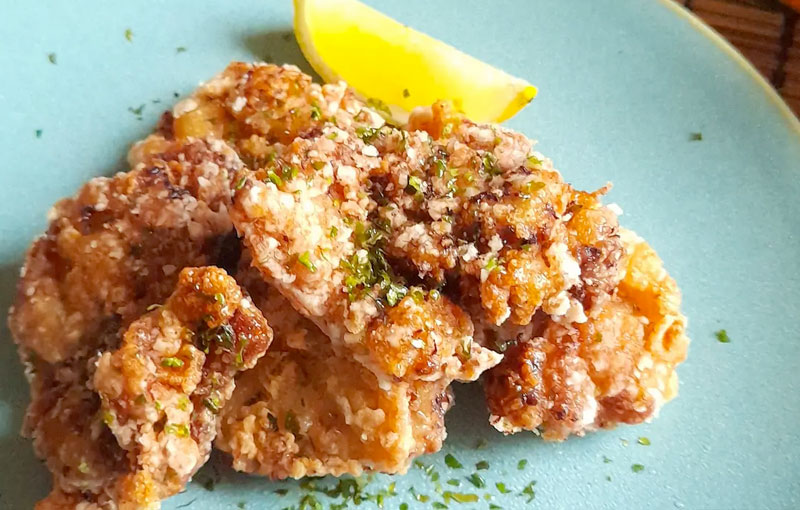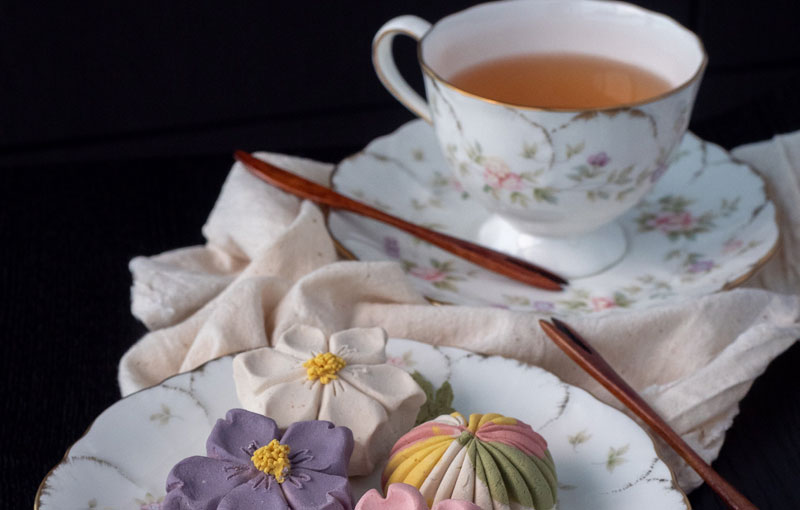The Japanese Christmas cake is a layered spongy cake, filled with fresh whipping cream and strawberry slices in between layers, often referred to as strawberry shortcake. The cake is finished with a whipped cream frosting and decorated with strawberries, chocolate, or other seasonal fruits.
This blogpost will guide chefs through the cake’s history within Japanese Christmas culture, how to make the cake and reveal alternative cakes consumed during the festive season in Japan.
Eaten traditionally on Christmas Eve, the cake, adapted from Western culture, was first introduced in Yokohama during the Meiji period in 1910. It was seen as a luxury product only available to the wealthy due to milk, sugar, butter, and strawberries being a rarity.
However, it wasn’t until after the Second World War, in the 1950s that the cake started gaining traction. Re-introduced by the Japanese upper-class during the country’s Westernisation wave, the cake represented commercialism and prosperity for the Japanese.
This secular symbol of celebration only arose after decades of media promotions that portrayed Christmas as a stylish and romantic event. The colour and shape of the cake are also very symbolic as the cake’s red and white colours are reminiscent of the Japanese flag.
The Japanese Christmas cake recipe is very simple, with a handful of ingredients widely available. The preparation process, however, is lengthy and involves many processes.
It’s important to follow each step to ensure the cake comes out just perfect. For example, having the right amount of sponginess, without being too soft or hard, as well as having the right amount of sweetness without being too sweet that it overpowers the whipped cream flavour and strawberry tartness.
To view the recipe, click here. Just an additional tip, it would be great to include a short historic description when serving the cake in your restaurant, so people can learn about its rich heritage and symbolism in Japanese culture.
Although the strawberry shortcake is the ultimate Christmas cake in Japan, there are a selection of other traditional European cakes that are starting to gain popularity in Japan.
The German Stollen, French Yule log and Italian Panettone are just a few of the cakes that are also widely consumed in Japan during Christmas.
Now that you understand the culture and meaning behind eating the fluffy strawberry shortcake on Christmas, create this dessert for your restaurant and let customers appreciate the symbolic meaning the dessert maintains in Japan.
Learn more about Honteri, the chef’s secret weapon used to bring a unique flavour in the cake and sign up to our newsletter for all the latest news and updates within the Japanese foodservice industry.
Although Japan acknowledges Christmas, it isn’t a national holiday, and it isn’t celebrated with the same gusto as Westerners. It is instead seen as a romantic festival similar to Valentine’s Day where couples get to spend some time together, mainly on the 24th of December.
Throughout the years, apart from the traditional Christmas cake, other interesting food habits have been picked up with people eating fried chicken, potato salad, and wagashi – quite different from the homecooked turkey consumed in the West.
This blog will explore how to re-create the popular dishes consumed in Japan on Christmas Day.
Eaten as a side dish on Christmas Day in Japan, the potato salad comes from the German culture of consuming the dish during the festive season. Adding a Japanese touch to the salad would make it a great starter for your Christmas dinner menu.
Preparation method:

Since turkey is hard to find in Japan, the fried chicken tradition became popular in the 1970s thanks to KFC’s marketing campaign, with people now visiting the franchise every Christmas to mark the big day.
Inspired by this tradition, we have created Japanese Miso Fried Chicken Karaage. Containing a traditional mix of sake and ginger, with a touch of Honteri for sweetness. This dish makes a perfect main for your three course Japanese Christmas dinner.

Wagashi is a popular Japanese sweet consumed throughout the year in different shapes and flavours that vary depending on each season. The Nerikiri wagashi in particular, makes a great Christmas dish as it can be made in any festive shape such as a snowman, Santa, reindeer, Christmas tree and more.
Preparation Method:
This mix of traditional (wagashi) and Western-styled Japanese Christmas dinner would make a great menu choice for your restaurant during the festive season. More festive recipes can be found on our recipes page. You can learn more about Mizkan Chef’s products through here and sign up to our newsletter for all the latest news and updates within the Japanese foodservice industry.
New Year is Japan’s most important holiday – a chance for familial relaxation, reflection on the past months and optimism for the year ahead. Of course, No celebration of this magnitude would be complete without great food.
Japanese years are traditionally viewed as completely separate entities, with each new year providing a clean slate and a chance for a new start. Consequently, all duties and chores are supposed to be completed by the end of the year, with bonenkai parties (“year forgetting parties”) held with the specific purpose of leaving the old year’s worries behind. Like all good celebrations, Japanese new year is held across a number of days, where specific foods – eaten for their symbolic importance – are enjoyed.
To help mark the occasion, we have tasked our skilled development chef Ron Laity with creating some authentic and delicious recipes that will make any nen-matsu nen-shi (end and start of year) celebrations go off with flavoursome fireworks.
Toshi-koshi soba
Traditionally enjoyed on New Year’s Eve, Toshi-Koshi Soba (year-crossing noodles) is a simple and warming dashi broth typified by its long buckwheat noodles that symbolise longevity. Chef Ron has faithfully recreated this simple, yet delicious recipe.
Osechi Ryori
It’s no surprise that the most important meal of the year is also one of the most complex and intriguing. Similar to the classic bento box, Osechi Ryori is usually packed in 2-3 layers of lacquer boxes (ojubako) with many dishes, each serving as well-wishes for the coming year. Eaten with the family on New Year’s Day, Chef Ron offers some insights into its contents and what they symbolize
“Yellow Egg Roll or Datemaki is a sweet egg roll, the scroll-like omelette shape symbolizes the acquisition of knowledge and culture. Shrimp are included as a wish for a long life, even after your back has bent over like a shrimp! Burdock in Sesame Sauce or ‘Gobo’ is a thin and long vegetable whose roots are firmly planted in the ground and is supposed to bring good luck and stability to the household. Salmon Roe is eaten to wish for a prosperous family. Konbu Seaweed Rolls. Lotus Root Pickle is another vegetable that brings good luck. The many holes on the surface of renkon symbolize a good outlook for the future. Tatsukuri, also known as gomame, is a dish of small crispy sardines seasoned with sugar, soy sauce, and sweet sake. The name tatsukuri, literally translated as ‘rice farming’, comes from a custom to scatter baby sardines in a field as fertilizer, wishing for a good harvest. The kanji for gomame is written as 50,000 grains of rice, also symbolizing the wish for abundant crops.”
Kagami Mochi
Literally meaning “mirror rice cake”, Kagami mochi is a special delicacy consisting of two mochi – one sat on top of the other. Dedicated to the Gods during the New Year, the two mochi symbolize the going and coming years, or “yin” and “yang”. The kagami mochi is kept uneaten (for decoration purposes) until the 11th January, when people can – FINALLY – indulge in this delicious cake. Chef Ron has yet again been true to the original and authentic recipe, his hands still stinging from pounding the rice in the traditional manner!
Let’s face it, Christmas this year is going to be a little different for everyone, but in Japan they have been doing things a little differently since the 1970’s where a curious festive tradition has taken hold.
Many Japanese people acknowledge Christmas, but don’t necessarily celebrate with the same gusto as westerners, while some treat it as a romantic holiday similar to Valentine’s Day, marking the occasion with upscale dinners. Yet did you know that an estimated 3.6m choose to visit KFC to mark the big day, often resulting in large queues and 3-4 hour-long waits on the 25th December?
A nationwide tradition with its genesis at Japan’s very first KFC, owned by businessman Takeshi Okawara, it is said that Okawara created a novelty ‘Party Barrel’ of fried chicken as a way to celebrate Christmas and, in the autumn of 1970, set about furiously marketing it to his customers, with rapid uptake.
It took just four years for KFC Japan to take the Party Barrel or Kurisumasu ni wa Kentakkii, translated as ’Kentucky for Christmas’ nationwide. The innovative marketing campaign proved such a roaring success that Takeshi Okawara was propelled to KFC CEO just a decade later, a position he held for 18 years.
In tribute to this extraordinary custom, and to help our friends and followers discover more Japanese food traditions this festive season, we have tasked our talented development chef Ron Laity to come up with three special dishes – Mizkan Fried Chicken (MFC), our take on a delicious izakaya and bento box favourite chicken karaage – a traditional mix of sake and ginger, with a touch of Honteri for sweetness, miso for piquancy and buttermilk for moisture retention – an incredible Strawberry Christmas shortcake, made to a traditional recipe, and a sweet and fluffy Christmas eve treat, a spiced Gingerbread man. Take a look here!
The very beginning of November marks Vinegar Day – an American awareness day by definition, created to ‘celebrate the rainbow of preparations and flavours of vinegar’, demonstrating to consumers that there’s more to the category than just white, malt and balsamic.
As a producer of an array of authentic Japanese seasonings and vinegars, this is definitely an ethos that we adhere to and we couldn’t let the day go past without using it to introduce our very own range of vinegars to a wider UK audience of chefs.
We’ve been perfecting our vinegar brewing craft for more than 200 years; for example, Mizkan pioneered brewing vinegars with sake cake lees, creating the unique combination of rich umami with vinegar tang for the sushi vinegars that we are famous for today.
Vinegar has long been an important ingredient in Japanese cuisine and culture. It is the element that that gives the rice in sushi its distinctive flavour, while also being prized for its numerous health benefits, including aiding circulatory issues and countering fatigue.
This magic ingredient comes in three main variants, Pure Rice Vinegar which is typified by its clear aroma, rich flavour, and mellow acidity, Pure Sake Cake Vinegar (sake cake are the lees left over from the sake making process) which is typically aged for a deeper , more full bodied umami flavour and Spirit Vinegar which is light and mild in comparison. Each of our vinegars has a different level of taste and tanginess to suit a range of dishes and preferences – for more detailed information visit our product page here https://www.mizkanchef.com/en/japanese-ingredients/vinegar/
To celebrate Vinegar Day, our highly skilled development chef Ron Laity, has created a sumptuous Vinegared Black Belly Pork & Pickled Apple Slice dish using our Shiragiku Vinegar – a spirit vinegar with a mellow acidity, making it the perfect accompaniment to pork when mixed with a sweet maple syrup.
If you’re a chef and want to recreate this dish, fear not – Ron has provided a detailed recipe here https://www.mizkanchef.com/en/chef-recipes/vinegared-black-belly-pork-pickled-apple-slice/ If you do create your own version, be sure to share it with us on Instagram @MizkanchefUK. Or, if you’d prefer, do share with us your own vinegar-inspired creation as we’d love to see it. Let’s make every day vinegar day!